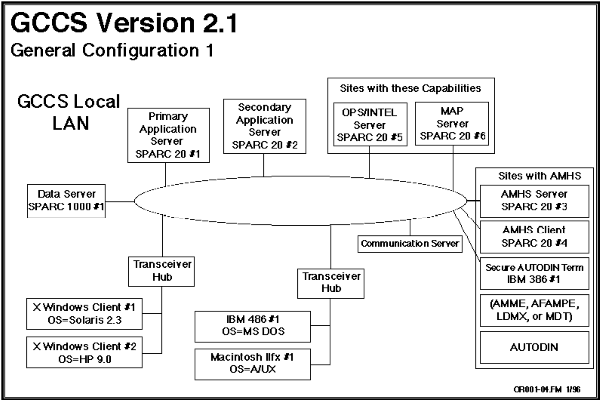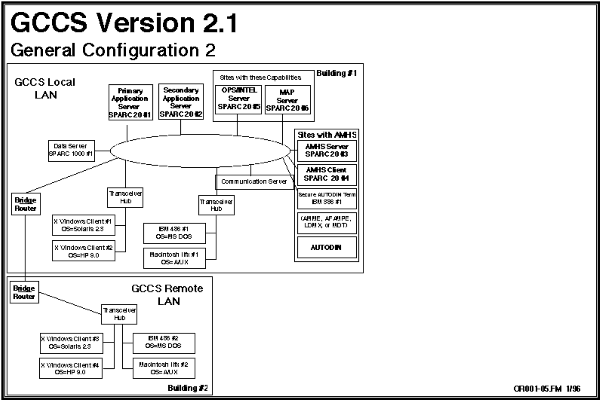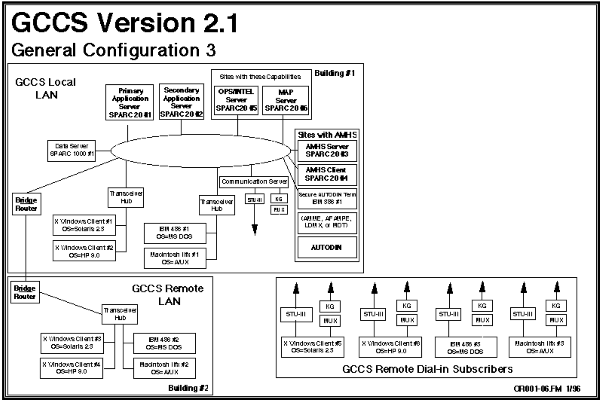
Publication Date: 16 February 1996
System Version: GCCS 2.1/Update 4
Web Page Created: 14 March 1996
Setup. None.
Now that you have a road map of what you will be doing for the next hour or so, the lesson continues by laying some basic groundwork for understanding and using JOPES in the new GCCS environment.
OBJECTIVE. From several alternatives, select the best definition regarding the purpose of JOPES running in the GCCS environment.
So What is JOPES? JOPES is the integrated, joint, conventional command and control system used by the Joint Planning and Execution Community (JPEC) to conduct joint planning, execution, and monitoring activities. JOPES supports senior-level decision-makers and their staffs at the National Command Authority (NCA) level and throughout the JPEC. Combatant commanders use JOPES to determine the best Course of Action (COA) to accomplish assigned tasks and direct the actions necessary to accomplish the mission. JOPES is a system that includes people, procedures, policies, communications, and supporting Information Systems (IS) software.
JOPES Software Applications. JOPES is not a single application, rather it is a set of applications that can be used independently but interact with a shared database. The JNAV window is where most JOPES applications (except JFAST, which must run on a DOS machine) can be accessed. Other notable exceptions are the RFM and IMS tools that are started from the Launch Window. These JOPES applications are grouped by function and are defined below.
Note: The applications are discussed in the order as shown on the JNAV window.
Force Module Editor (FMEDIT). Although not yet available in GCCS Version 2.1, this application will allow a user to create and edit Force Modules.
GCCS Status of Resources and Training System (GSORTS). GSORTS provides information about the status and location of registered units of U.S. military forces and other registered foreign or domestic agencies or organizations.
Transportation/Scheduling. This grouping includes applications used to analyze transportation feasibility and schedule movement requirements against movement assets.
Scheduling and Movement (S&M). S&M allows the user to review, update, schedule, and create manifests of both Transportation Component Command (TCC) carrier and organic movement data before and during deployment. It provides the capability to review and analyze an extensive variety of source requirements and scheduling and movement data.
TCC External System Interface (ESI). TCC ESI provides a link between JOPES and TCC scheduling systems. It also supports the TPFDD validation process.
Sustainment Modeling. This grouping of applications includes models used to plan personnel, logistics, and other support required to maintain and prolong operations or combat.
Force Augmentation Planning and Execution System (FAPES). FAPES furnishes planning information for mobilizing forces, monitors mobilization, and displays data to the user.
Individual Manpower Requirements and Availability System (IMRAS). IMRAS captures and integrates manpower and personnel planning capabilities across the JOPES mission areas of mobilization, deployment, employment, and sustainment. It prescribes one set of planning and execution procedures for application in both crisis and deliberate planning situations to support decision makers and personnel planners. It also adds personnel replacement requirements to the TPFDD. Development of IMRAS continues because of the creation of personnel replacements is the only capability currently available. This application retains its old name of Nonunit Personnel Generator (NPG) until additional capability is added.
Logistics Sustainment Analysis and Feasibility Estimator (LOGSAFE). LOGSAFE estimates logistics sustainment requirements of a proposed OPLAN for deliberate or crisis planning, evaluates overall logistics feasibility of OPLANs and COAs, and furnishes sustainment data to transportation feasibility analysis tools. It also generates CIN records for TPFDD.
Medical Planning and Execution System (MEPES). MEPES assists the medical planner in quantifying the impact of an OPLAN on the medical system. MEPES can define Medical Working Files (MWF), compute the medical requirements, and print an appropriate set of reports. It also provides the algorithms for determining personnel replacements created by NPG.
Reports and Retrievals. This grouping of applications provides you with a variety of predefined or user-defined reports and displays.
Reports. Reports allows the user to generate various reports with predefined formats that give requirements detail data, FM data, and results of OPLAN analyses.
System Resources. This grouping of applications allow functional management of JOPES (such as permissions) and quick navigation within JOPES.
Reference File Administration (RFA). RFA provides the capability to update and maintain the following reference tables in the JOPES Core database:
Note: RFA use is restricted to DISA/Joint Interoperability and Engineering Organization (JIEO)/TEXNCP.
Communications. This grouping of applications allows you to: 1) communicate with other JOPES users informally or in a formal, controlled format; 2) access data; and 3) transfer data and textual files.
Internet Chatter. This application allows users to participate in teleconference-style communications, similar to a telephone teleconference.
SIPRNET WEB (SWEB). The SWEB provides access to graphical and textual information from various sites and sources. If you have attended the current JBOC, you used the Netscape application to browse the JOPES Users' Guide.
Now that you know about the JOPES applications, you should be ready to attach a definition to the correct JOPES term.
OBJECTIVE. Given a list, match the GCCS or JOPES definitions with the appropriate terms.
Client. A client is a computer that requests or uses the services provided by a server. For example, in our current environment, the Sun computer acts as a server, and various desktop computers act as clients.
Local Area Network (LAN). A LAN provides a means of communication between connected workstations, printers, and servers using transceiver cables and fiber optic cables over a relatively small area.
Wide Area Network (WAN). A WAN provides a means of communication between connected workstations, printers, and servers usually using some common carrier communications capabilities over a large area.
Defense Information System Network/Secret Internet Protocol Router Network (DISN/SIPRNET). The SIPRNET provides a Secret level communications capability to the Defense Information System Network. The SIPRNET is the communications link that provides the WAN connectivity.
JOPES Core Database. The JOPES Core Database contains the standard reference file data and OPLAN-related requirements and transportation data.
Note: In general, a database is a collection of data managed by specialized software. Oracle is the database software primarily in use within GCCS.
Note: Some applications, like GSORTS or JFAST, maintain a separate database that shares data with the JOPES Core database.
Now that you know something about LANs and WANs, you may be curious about the computers that can be used with GCCS.
OBJECTIVE. Given a diagram of GCCS hardware and communications connectivity, identify by name the equipment used within GCCS to support the JOPES applications.

Workstations/Clients. The workstation is where most people access the applications available on the LAN. A variety of workstations are used. The key to whether or not a particular type of workstation can be used is its ability to run some type of Windows software package. These workstations can function as dumb terminals or they can support some of the JOPES applications as well.
Note: Most locations are getting rid of the WIS workstation and have replaced them with one of the following types of workstations.
SPARC (OS Solaris 2.3). Many locations are purchasing the Sun SPARCstation as their preferred workstation. It can access all the applications except JFAST.
HP (OS HP 9.0). Hewlett-Packard also builds a machine that uses a version of UNIX, called HP 9.0, as an operating system. It has much the same capability as the Sun SPARCstation.
GCCS Communications/Connectivity. All of the computers have the power and capability to run programs in a stand-alone mode, but an enhanced planning efficiency is derived from sharing the same reference file information and computed results between planning cells and JOPES applications.
Remote LAN. Many locations also have one or more remote LANs connected to the GCCS local LAN (Figure 1-2).

Remote Dial-in. Remote users may also be connected to the network via a dial-in capability (Figure 1-3).

DISN/SIPRNET WAN. The GCCS local LANs around the world will be connected to each other via the DISN/SIPRNET WAN router (Figure 1-4).

Think of the whole GCCS system as one large computer with multiple processors and lots of users who, given the right permissions and skills, could theoretically access all the system data and applications from any location in the system. If you need the information, know where it is, and how to get to it, the system will support your planning requirements. The rest of the lesson shows you where the GCCS sites are located and the various jobs/positions associated with JOPES.

JOPES Database Sites. The underlined sites in Figure 1-5 indicate JOPES database sites. These database sites will maintain their OPLAN data and the OPLAN data from any attached, application only, site.
GCCS is more than hardware and software; it also includes the personnel required to keep it running and provide user support and training.
OBJECTIVE. From a list, match the GCCS or JOPES position title with the associated task.
Note: Functional Managers are occasionally referred to as Functional Database Managers.
Database Administrator (DBA). The Database Administrator keeps the JOPES database accessible and accurate. Their duties include backups of the JOPES database.
Information System Security Officer (ISSO). The Information System Security Officer ensures proper security measures are implemented and adhered to by all system users and administrators. They provide new users access to GCCS. They also formulate the procedures governing the physical and personnel access controls that must be in place.
Network Administrator. The Network Administrator keeps the appropriate network hardware and software functioning. DISA Network Administrators are also responsible for SIPRNET WAN operations.
Site Administrator (TLCF). Teleconference Site Administrators control and manage the teleconference suite of applications. Their duties include creating a newsgroup, IRC channel, or SWEB page. Additionally, the Teleconference Site Administrator controls access to a newsgroup, IRC channel, or SWEB page.
Users. This category includes all those individuals who want and need to do nothing more than access the system to use one or more of the applications available. They range from the teleconference user, to the OPLAN creator, the TPFDD sourcing commands, the transporters, the report builders, and the slide creators.
Summary. During this lesson, you have been exposed to a myriad of terms and definitions that included hardware and communication topics. Servers, LANs, and WANs should now be a part of your vocabulary as well as SIPRNET, Network Manager, and System Administrator.
Think of GCCS as one large computer spread between multiple sites, connected by classified LANs or dial-up modems, running integrated application software, and managed by trained system specialists. When it is all done, you should be able to login at a location and access all the resources required to do your job.